This cucumber soap is filled with natural ingredients such as fresh cucumber puree and uplifting essential oils. Learn to create a soothing bar of soap using the cold process method.

I live in the Garden State. Yes that's right, New Jersey. The state known for it's closeness to NYC, it's stinky highways, industrial areas, and also it's beaches. What most people don't know is that we do have plenty of greenery here, as the name suggests. Folks really love to grow their veggies in our neck of the woods and when summer rolls around, we have cucumbers for days.
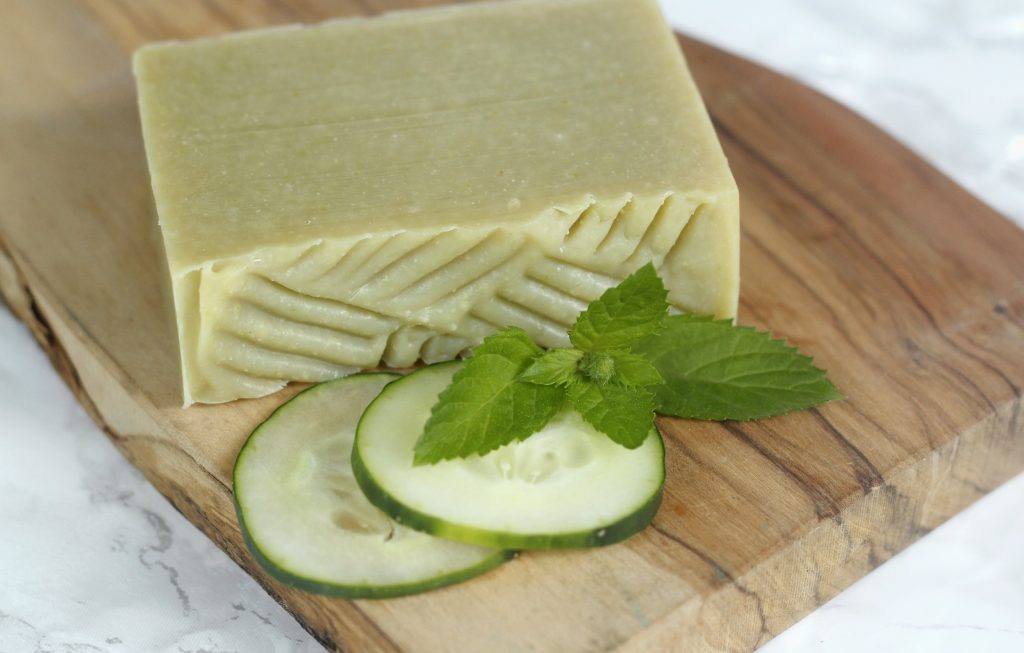
Which, of course, is a more than enough reason for me to make some cucumber soap. And this one is a full on cucumber soap in that I replaced the ENTIRE water content with cucumber juice (seeds, peels and everything). To stay with the summery theme, I scented it with a fresh, invigorating mix of spearmint and peppermint essential oil. Oh my!

Let's take a look at this cucumber mint soap recipe, shall we?
If you've never made cold process soap before, make sure you check out my posts on lye safety, my beginner's tutorial and my list of equipment needed.
Disclaimer: This post may contain affiliate links, meaning at no additional cost to you, will I earn a commission if you click through and make a purchase.
What you'll need:
Equipment
- two heat resistant containers (non aluminum) - a smaller one to mix your lye and a bigger one (50 oz capacity) to melt your oils and mix your soap in
- stick blender / immersion blender
- blender (to prepare your cucumber juice)
- Crafter's Choice silicone loaf mold
- silicone spatula
- plastic fork to deck out the top (optional)
Cucumber Soap Recipe
This recipe will yield around 42 oz of cucumber mint soap (8 average sized bars), you can resize the recipe to your heart's desire using a lye calculator. It is always a good idea to run every recipe you find online (including this one) through a lye calculator, just to be safe.
This recipe uses a superfat of 6% and a 35% lye concentration.
- Cucumber juice (1 medium size cucumber and the peel of another one blended): 7.7 oz. / 218 g
- Lye (sodium hydroxide): 4.1 oz. / 117 g
- Tallow: 9.4 oz. / 268 g (32%)
- Olive Oil (Pomace): 8.9 oz. / 251 g (30%)
- Coconut Oil: 7.7 oz. / 217 g (26%)
- Castor Oil: 1.8 oz. / 50 g (6%)
- Hemp Oil: 1.8 oz. / 50 g (6%)
- Peppermint Essential Oil: 12 g
- Spearmint Essential Oil: 12 g
How to Make Cucumber Soap
- Safety First: Put on your googles and gloves and make sure you're not soaping around children and/or pets. Keep your space ventilated
- Cut the cucumber into small chunks and add the peel of another cucumber (optional, this will give you a deeper hue with little green specks), blend until everything turns into a smooth liquid. If you end up not having enough cucumber juice or your liquid seems too thick add a little distilled water.
- Put cucumber juice in the freezer until it forms a slushy, but isn't frozen solid yet.
- Slowly and carefully add lye to the cucumber slushy, stir until lye is completely dissolved. Place the container with lye solution in an ice bath. This is important since the cucumber juice can cause the lye to heat up A LOT and you want to prevent it from scorching.
- Melt and mix the oils
- Add essential oils to the oils
- When lye solution and oils are both below 100 Degrees F, slowly pour lye solution down the shaft of your stick blender into the oils.
- Burp (gently tap) your stick blender to release any air bubbles and stick blend your soap until it reaches a light pudding consistency.
- Pour soap into your mold
- By now the soap is likely to be at thick trace (thick pudding consistency) and you can get creative texturing the top. I used a plastic fork to create sort of a checkerboard look.
- If you wish to gel your soap (I did) wrap a thin towel around it and keep an eye on it for the first hour. If you see a crack forming on top, the soap is getting too hot and you need to take the towel off.
- Unmold after 24 - 36 hours, cut cucumber mint soap into bars and cure for 4 weeks.
- Enjoy!
6 Month Soap Update:
We all know that cold process soap can change over time: the colors may fade or even worse the scent may become different or disappear all together (gasp!). That's why I like to show you how the soaps that I make here look like after some time has passed.
Here's the cucumber mint soap I made this past summer:

This little slither was all I could rescue from my family and friends that were eager to get there paws on this delightful soap - and then they came back for more. As you can see the soap didn't keep its greenish hue. The scent however stayed nice and strong, I really enjoy how the spearmint rounds out the more in your face mint scent of the peppermint with its soft sweetness. And the lather, you guys, is sooo nice and creamy (*swoon*). I will make this cucumber mint soap again in the future for sure, not that I really have a choice 😉
Until next time. Happy Tinkering!







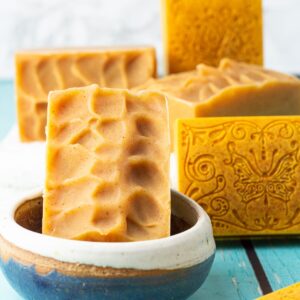
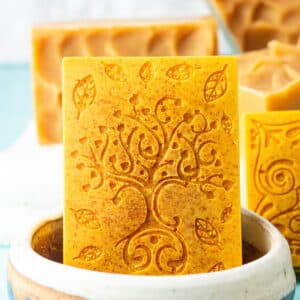
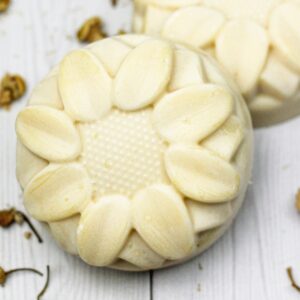
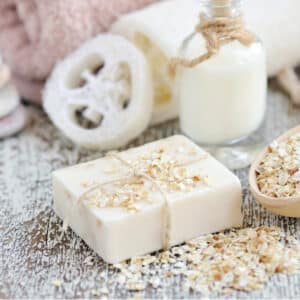
Krystel
Hello,
Thank you for this recipe 🙂
Is there any substitute for tallow? I can't find it where I live.
Krystel
Celine
Hi Krystel,
you could substitute with lard or sustainable palm oil. Be sure to run you recipe through a lye calculator (I use SoapCalc ) after doing any changes to a soap recipe as the amount of lye will likely change.
I hope that helps, happy tinkering!
Kandi
I noticed you have more lye than water, wouldn't that make a lye heavy soap?
Celine
Hi Kandi,
thank you for your question. The water in this recipe is fully replaced by the cucumber juice. So, we have 7.7 oz (218g) cucumber juice and 4.1 oz (117g) of lye which brings us to a lye concentration of 35 %.
I hope you find this helpful.
Happy Tinkering!
Hope
Hello, Celine. When you say, 1 medium size cucumber and the peel of another one blended, do you mean a whole cucumber including its peel and the peel of an additional cucumber? Thank you
Celine
Hi Hope, good question! Yes that’s right. I used the extra peel to give the soap a little more exfoliating power and a little bit more color. Happy Tinkering, Celine
Hope
Thank you. Where in NJ do you reside? I reside in NJ as well. You can email me if you do not want to disclose it here. My email is [email protected]
Akpone Fidelis
I appreciate your efforts to put up this simple recipe. I will give it a try. But what are the advantages of cucumber soap?
Simy
Hi
Can we use green clay powder to this receipe for More colour
Will it have any bad reaction with the cucumber?
Celine
Hi Simy, I imagine that you can do that. I don't see why it would have a bad reaction, but I personally haven't tried it with this recipe.
Licia
Thanks for this recipe. I am a beginner but I will surely try this.
Celine
You’re welcome Licia! Let me know how it turns out 🙂
Rebecca
Hi,
I love your recipe. I was wondering if you know of anyway to incorporate aloe into this
Celine
Hi Rebecca,
you can incorporate fresh pureed aloe gel into cold process soap. I haven't tried it with this particular recipe though. You will most have to lower the amount of cucumber juice to make up for the liquid that's in the aloe. I wouldn't go higher than 1 oz per pound of soap. You'll have to do some experimenting. Happy Tinkering!
Sarag
Hello,
i recently made a soap using half cucumber juice and half aloe vera gel straight from the plant. i froze this for a couple of hours and used it as water substitute. The aloe turns yellow when you add the lye, it made a nice soft yellow bar. The bars are curing now bit I can alreadt tell you it reached thick trace very quickly!
Tiffany
Hi there! Thank you for this recipe. I’m still tinkering with melt and pour goat milk soap. So not the same as yours. Do you think adding cucumber to the melt and pour would water it down?
Celine
Hi Tiffany, I wouldn’t recommend adding fresh fruits or vegetables to melt and pour soap. It doesn’t have the same ph as cold process soap and you will likely have a mold issue. Anything that’s dry like flowers or herbs should be ok. Hope that helps. Happy Tinkering:)
Maria
Hi, I am working with three oil, coconut oil, olive oil and castor oil. So how can I adjust this recipe?
Thankful for the recipe
Celine
Hi Maria! Try 30% coconut oil, 65% olive oil and 5% castor. Run it through soapcalc.net to adjust to your mold and find amount of lye needed. Happy Tinkering:)
Laura Annias
doesn't lye require heat to disappear from the soap?
Celine
Hi Laura, with the cold process method you won’t need to heat your soap. The oils and lye solution need to be thoroughly mixed and will start the chemical reaction necessary to make soap without heating.
Mariah
Hey Celine, As a beginner in soap making, I just loved your recipe, Thank you very much, I sincerely appreciate.
I would like to try this recipe,but with 95% coconut oil and 5% olive oil (which will be spared as part of superfat %), as in my area other oils like olive , almond castor e.t.c tend to be very expensive, never the less coconut oil is easily available and quite affordable too.
I humbly request you to shed some light on it.
Eagerly awaiting your response.
Thank you once again 😊
Kindest regards,
Mariah
Celine
Hi Maria, I'm glad you like the recipe. In cold process soap making you don't spare oils for the superfat portion. Lye doesn't care whether oils are added at trace or right from the beginning, it's an "equal opportunity saponifier" meaning whatever fatty acids are found in the mix it will turn into soap. If you're making hot process soap, then yes you add the superfatted oil after the soap has saponified. If you're looking to make coconut soap I would highly recommend making a 100% coconut soap at 20% superfat and leave the olive oil out (it will spoil over time). Here's a great recipe . Hope this helps. Happy Tinkering 🙂
Ingrid Cotey
Hi Celine,
I am reading the instructions carefully on the soap making process, but I don't see where you put in the tallow. Is there a substitute for that? and where do you put in tallow,
Celine
Hi Ingrid, you’re right that step isn’t very clear. I’ll change it. Where it says “melt and mix the oils”You melt tallow together with coconut oil and add pomace, hemp and castor oil once melted. Hope that helps. Happy Tinkering!
Roopa D
Hi Celine, Thanks for the recipe, for papaya soap the puree wasn't frozen, pls help on that, and since we are using fresh fresh puree and juice, is there chances of fungus to some, do we need add any preservatives, pls clarify
Celine
The papaya doesn’t need to be frozen for this recipe. You can freeze the soap right after you make it to prevent overheating. This soap is made with lye which will create a ph level where mold and bacteria can’t live. The shelf life of the soap is at least 6 months you won’t need a preservative.
Celine
Hi Roopa, the papaya wasn’t frozen because I didn’t replace the entire water content with it. It was added after the lye was already mixed with water. I hope that helps.
Jennifer K Taylor
Hi there, when you say place the lye solution in an ice bath, what do you mean specifically? Put ice around the outside of the container? Any details would be much appreciated as I don't want to mess this up!
Thank you!
Celine
Hi Jennifer, I typically put the container that I will be mixing the lye solution in into a bigger pot which is filled with cold water and ice. As you would typically do when making milk soap. I hope that helps!
Blessing
wat is cartol oil
Celine
Castor oil is a plant derived oil commonly used in skincare products
Patricia Wilcox
Great recipe!! Would like to add a teaspoon of green clay powder of some sort to maintain the light green color of the soap. Any suggestions?
Celine
Hi Patricia, i've used nettle leaf powder in this recipe Avocado Soap Recipe with Fresh Avocado and Lots of Shea Butter. It worked great.